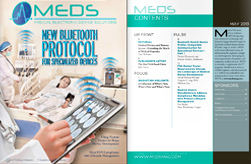The component makers go to great efforts to chase after these device makers. All the medical IC chip manufacturers such as Texas Instruments, Renesas, STMicro and Freescale come up with new silicon, modules and supporting software to help solve the device makers’ design challenges. The software companies such as Wind River, MKS, LDRA, Visure Solutions and others provide tools to help these device makers be in compliance with IEC 60601-1 (now in its 3rd edition) and FDA 510(k). Design consultants, such as LogicPD and Sterling Medical Devices, provide design expertise to solve tough design problems when these device makers run into trouble. Additionally, there is a whole host of consultants to help with FDA clearance and compliance issues.
Device makers such as Johnson & Johnson, Medtronic, St. Jude’s Medical, GE Healthcare and Philips Healthcare strategize on how to sell their products to hospitals, home healthcare, health institutions and, in some cases, the retail chains. No one wants to use unsafe medical products with unproven quality. That is why the FDA is so important in regulating medical technology. One consultant put it this way, “To be successful in the medical technology business, you need to have good ideas, a good team, ample funding plus the FDA!”
Big responsibilities rest upon the shoulders of hospital administrators and those with procurement authority for medical technologies and products. The important questions are, “How safe is safe enough?” and “How do I know about and manage the risks associated with purchasing these medical technologies and products?” The stakes are high here. We hear stories about car manufacturers recalling automobiles because they accelerated uncontrollably or caught fire in a collision, or of manufacturers recalling baby cribs because they were unsafe, causing injury or death. When it comes to medical technology, safety concerns are just as important. For example, a friend of mine shared his story of when his implantable defibrillator delivered the high voltage shock to “jump start” his heart when his heart was perfectly fine. A first examination revealed no problems, but when it happened again in the hospital parking lot, he went back and the unit was replaced. Another incident was a “lead problem” associated with an implantable defibrillator installation. It was a more generic design problem and that model was recalled. A recall in this situation means surgery. Another kind of risk is “hacking.” This has been discussed many times in various conferences. Imagine a device such as an implantable defibrillator or an insulin pump being hacked. It could cause major problems for the patient.
Obviously, when it comes to patient safety and risk management, a well-informed decision maker is in a better position than those who are not. An organization called Medical Device Innovation, Safety and Security Consortium (MDISS) has proposed a Fuzz test method to help reduce the risks with medical electronic devices.
In this May issue of MEDS, we have articles about Fuzz testing and the FDA’s Human Factors Program. In June, MEDS will sponsor the Intelligent Systems Conference in Chicago, IL, where Dale Nordenberg, MD, Executive Director/Medical Device Innovation, with the Safety and Security Consortium, MDISS, will lead a panel on “Understanding the Medical Device Procurement Process by the Hospitals.” Also included will be presentations relating to Fuzz testing, FDA 510(k) Clearance, a Home Healthcare panel and other relevant medical technologies. www.issconference.com.


